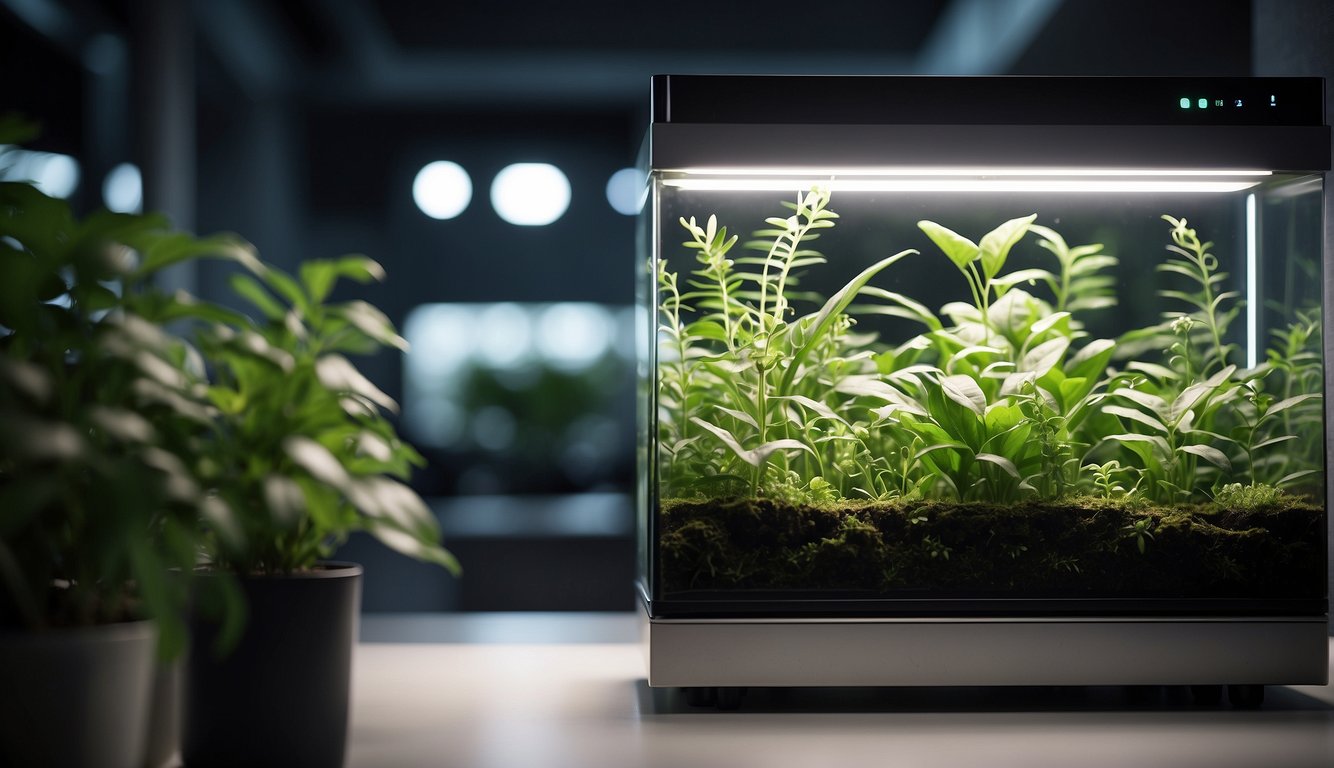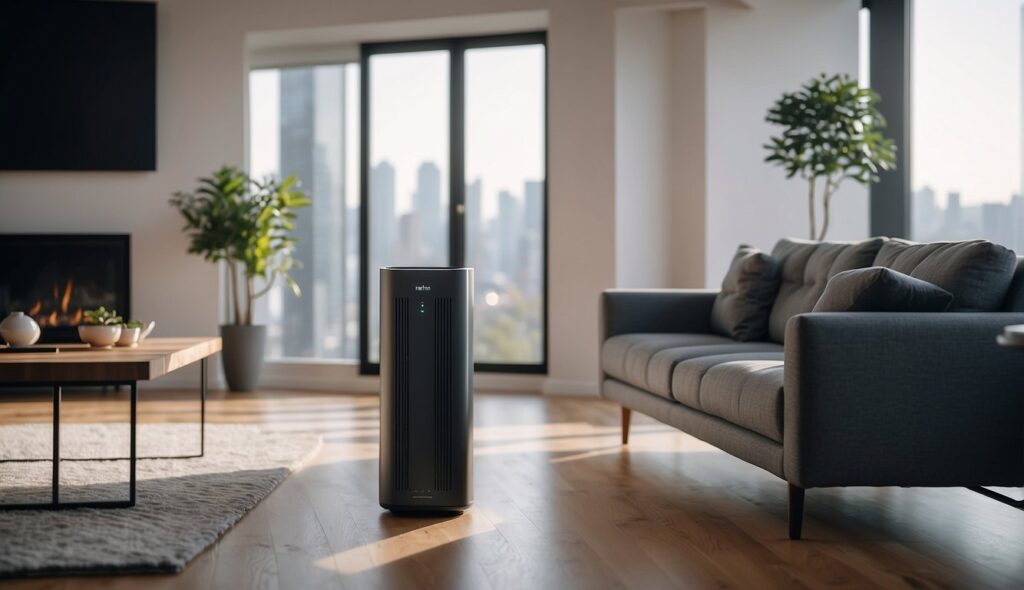Air pollution is a major environmental issue that has significant impacts on public health. According to the World Health Organization (WHO), outdoor air pollution causes 4.2 million premature deaths worldwide each year. Indoor air pollution is also a major concern, particularly in developing countries where people often rely on traditional cooking fuels such as wood and charcoal. However, even in developed countries, indoor air pollution can be a problem, particularly in homes with poor ventilation.

Advancements in air filtration technology have led to the development of more efficient and eco-friendly air purifiers. These devices are designed to remove harmful particles and pollutants from the air, improving indoor air quality and reducing the risk of health problems. However, the impact of materials on filtration efficiency is an important consideration when choosing an air purifier. Some materials, such as activated carbon and HEPA filters, are highly effective at removing pollutants, while others may not be as efficient.
At the same time, it’s important to consider the health and environmental implications of air purification. Sustainable practices in air purification can help reduce the environmental impact of these devices, while also promoting better health outcomes. In this article, we will explore the latest trends and innovations in eco-friendly air filtration, and discuss the key considerations when choosing an air purifier.
Table of Contents
Key Takeaways
- Air pollution is a major environmental issue that has significant impacts on public health.
- Advancements in air filtration technology have led to the development of more efficient and eco-friendly air purifiers.
- Sustainable practices in air purification can help reduce the environmental impact of these devices, while also promoting better health outcomes.
Air Pollution and Public Health
Air pollution is a major environmental health problem that affects people worldwide. It is caused by a variety of pollutants released into the air by human activities such as transportation, industrial processes, power generation, and burning of fossil fuels. These pollutants include particulate matter, ozone, nitrogen oxides, sulfur dioxide, and carbon monoxide.
Exposure to ambient air pollution has been linked to a wide range of health impacts, including respiratory and cardiovascular diseases, stroke, cancer, and adverse birth outcomes. According to the World Health Organization (WHO), ambient air pollution is responsible for an estimated 4.2 million premature deaths worldwide every year.
Particulate matter (PM) is one of the most harmful air pollutants, particularly the fine particles with a diameter of 2.5 micrometers or less (PM2.5). These particles can penetrate deep into the lungs and enter the bloodstream, causing inflammation and damage to the respiratory and cardiovascular systems.
To reduce the health impacts of air pollution, it is important to implement effective air filtration systems. Eco-friendly air filtration technologies have been developed to address the issue of non-degradable filters. These technologies use degradable nanofibers or silk protein nanofibers to create filters that are both effective and environmentally friendly.
In conclusion, air pollution is a serious threat to public health, and it is important to take action to reduce exposure to pollutants. Eco-friendly air filtration technologies offer a promising solution to this problem, and we must continue to invest in research and development to improve air quality and protect human health.
Advancements in Air Filtration Technology

As concern for air quality continues to grow, advancements in air filtration technology have become increasingly important. In recent years, nanotechnology has emerged as a key area of research in air filtration, leading to the development of nanofiber-based filters.
Nanofiber-Based Filters
Nanofiber-based filters are created using a process called electrospinning, which involves the use of an electric field to create polymer nanofibers. These fibers are then collected on a substrate to form a fibrous filter. The resulting filter has a much higher filtration efficiency than traditional fibrous filters, including high-efficiency particulate air (HEPA) filters.
One of the key advantages of nanofiber-based filters is their ability to capture particles as small as a few nanometers in size. This means that they are effective at capturing not only large particles such as dust and pollen, but also smaller particles such as bacteria and viruses. Additionally, because of their high filtration efficiency, nanofiber-based filters can be used in a wide range of applications, including in hospitals, clean rooms, and other environments where air quality is critical.
Eco-Friendly Air Filtration
In addition to the development of nanofiber-based filters, there has been increasing interest in eco-friendly air filtration. This includes the use of biodegradable materials in air filters, as well as the development of filters that can be reused or recycled.
One example of an eco-friendly air filter is a degradable nanofiber filter, which is made from materials that can break down naturally over time. These filters are not only more environmentally friendly than traditional filters, but they also have the potential to reduce waste and lower costs over the long term.
Overall, the advancements in air filtration technology are providing new ways to improve air quality and protect public health. With continued research and development, we can expect to see even more innovative solutions in the years to come.
Impact of Materials on Filtration Efficiency

When it comes to air filtration, the materials used in the filters play a critical role in determining the overall filtration efficiency. We have found that biodegradable materials such as nanofibers, polypropylene, ethylene, polyamide, and polyethylene are some of the popular choices for eco-friendly air filters.
Nanofibers, in particular, have gained a lot of attention in recent years due to their high surface area, small pore size, and low pressure drop. According to a study by Kim et al. (2023), electrospun nanofibers made from polyvinyl alcohol (PVA) showed a filtration efficiency of 86.81% and a quality factor of 0.11 Pa −1. These results demonstrate the potential of nanofibers as an effective material for air filtration.
Polypropylene is another popular material used in air filters due to its high melting point, good chemical resistance, and low cost. However, it is not biodegradable and can have a negative impact on the environment. Therefore, researchers are exploring alternative materials such as ethylene and polyamide, which are biodegradable and have similar properties to polypropylene.
In addition to the materials used in the filters, the structure of the filter also plays a crucial role in determining its efficiency. For example, a study by Liu and Wang (2000) found that HEPA (high-efficiency particulate air) filters made from super fine glass fiber paper could achieve 99.9998% efficiency for particles larger than 0.3 μm. This demonstrates the importance of selecting the right material and structure for the filter to achieve the desired level of filtration efficiency.
Overall, the choice of materials used in air filters has a significant impact on their filtration efficiency and environmental impact. By selecting biodegradable materials such as nanofibers, ethylene, and polyamide, we can create eco-friendly air filters that are effective in removing pollutants from the air while minimizing their impact on the environment.
Health and Environmental Considerations
When it comes to air filtration, health and environmental considerations are of utmost importance. Particulate matter (PM) is a major concern, as it can cause respiratory problems and other health issues. PM is classified based on size, with PM10 being particles with a diameter of 10 micrometers or less, PM2.5 being particles with a diameter of 2.5 micrometers or less, and PM1 being particles with a diameter of 1 micrometer or less.
Indoor vs. Outdoor Pollution
Indoor air pollution can be just as harmful as outdoor pollution, if not more so. This is because we spend most of our time indoors, and indoor air can be up to 5 times more polluted than outdoor air. Common sources of indoor air pollution include tobacco smoke, cooking fumes, and cleaning products.
To address these concerns, eco-friendly air filtration systems are becoming increasingly popular. These systems use biodegradable filters that are less harmful to the environment than traditional filters. They also use less energy, which helps to reduce carbon emissions.
In addition to eco-friendly air filtration systems, there are other steps that can be taken to reduce indoor air pollution. These include using natural cleaning products, opening windows to improve ventilation, and avoiding smoking indoors.
Overall, it is important to consider the health and environmental impact of air filtration systems. By using eco-friendly filters and taking steps to reduce indoor air pollution, we can create a healthier and more sustainable environment for ourselves and future generations.
Sustainable Practices in Air Purification

As we strive towards a sustainable future, it is important to consider the impact of our daily practices on the environment. Air purification is an essential aspect of maintaining a healthy living environment, but it can also have negative consequences if not done sustainably. In this section, we will explore innovative materials and energy-efficient air purifiers that can help us achieve a more sustainable future.
Innovative Materials
One of the key ways to achieve sustainability in air purification is through the use of innovative materials. Biodegradable filters made from natural materials such as bamboo, hemp, and cotton can help reduce waste and promote a circular economy. These filters can be composted after use, reducing the amount of waste that ends up in landfills.
Additionally, reusable filters made from washable materials can help reduce waste and save money in the long run. These filters can be easily cleaned and reused multiple times, reducing the need for new filters to be purchased.
Energy-Efficient Air Purifiers
Another important aspect of sustainable air purification is energy efficiency. Energy-efficient air purifiers can help reduce energy consumption and save money on electricity bills. Look for air purifiers with an Energy Star rating, which indicates that they meet strict energy efficiency guidelines set by the U.S. Environmental Protection Agency.
Some air purifiers also come with smart features such as automatic shut-off and sleep modes, which can help save energy when the purifier is not in use. Additionally, some purifiers come with sensors that detect air quality and adjust the fan speed accordingly, reducing energy consumption.
In conclusion, sustainable air purification practices can help us achieve a healthier living environment while also reducing our impact on the environment. By using innovative materials and energy-efficient air purifiers, we can promote a circular economy, reduce waste, and save money on electricity bills.
Conclusion

In conclusion, we have seen that eco-friendly air filtration is a rapidly advancing field with exciting progress and perspectives. By combining engineering and materials science, we can create air filters that not only remove pollutants but are also sustainable and biodegradable.
We believe that the future of air filtration lies in the development of natural materials such as silk protein and bio-based electrospun nanofiber. These materials offer a promising alternative to traditional filters, which often rely on unsustainable materials such as plastic.
Moreover, eco-friendly air filters not only benefit the environment but also provide improved comfort to users. By reducing the use of synthetic materials, these filters can also reduce the incidence of allergies and other respiratory problems.
In summary, we are optimistic about the future of eco-friendly air filtration and the potential it holds for improving our health and the health of the planet. We encourage continued research and development in this field to ensure that we can create sustainable and effective solutions for clean air.
Frequently Asked Questions
What are the top-rated eco-friendly air purifiers for reducing allergens?
When it comes to reducing allergens, there are several eco-friendly air purifiers on the market that are highly rated. These include the Whirlpool Whispure Air Purifier, Coway Airmega Air Purifier, and the Guardian Technologies GermGuardian Air Purifier. These purifiers utilize HEPA filters that can capture 99.97% of airborne particles as small as 0.3 microns, including pollen, pet dander, and dust mites.
How do sustainable air filters compare to traditional ones in terms of performance?
Sustainable air filters are designed to be more environmentally friendly than traditional filters. They are made from renewable materials and can be recycled or composted after use. In terms of performance, sustainable filters can be just as effective as traditional ones. For example, the Briiv Air Filter uses 90% natural and renewable materials and is highly rated for its ability to filter out pollutants and allergens.
What natural methods can be used to purify indoor air effectively?
There are several natural methods that can be used to purify indoor air effectively. These include using houseplants like spider plants, peace lilies, and bamboo palms, which are known for their air-purifying properties. Additionally, opening windows and doors to increase ventilation, using essential oil diffusers, and regularly cleaning and vacuuming can all help improve indoor air quality.
What are the benefits of using eco-friendly air fresheners alongside air filtration systems?
Using eco-friendly air fresheners alongside air filtration systems can help improve indoor air quality and eliminate unpleasant odors. Eco-friendly air fresheners are made from natural ingredients and do not contain harmful chemicals that can be harmful to human health or the environment. Some popular eco-friendly air fresheners include beeswax candles, essential oil sprays, and activated charcoal bags.
Can you recommend any air purifiers that utilize technology similar to NASA’s for home use?
One air purifier that utilizes technology similar to NASA’s is the Molekule Air Mini. This purifier uses PECO technology, which destroys pollutants at a molecular level, making it highly effective at removing harmful particles from the air. The Molekule Air Mini is also designed to be energy-efficient and eco-friendly.
What should consumers look for in reviews when choosing an eco-friendly air filtration system?
When choosing an eco-friendly air filtration system, consumers should look for reviews that discuss the effectiveness of the system in removing pollutants and allergens from the air. They should also look for reviews that discuss the sustainability of the system, including the materials used to make it and its energy efficiency. Finally, consumers should look for reviews that discuss the ease of use and maintenance of the system, including filter replacement and cleaning.


